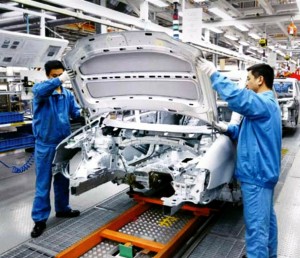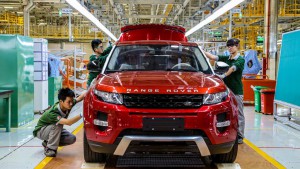
As Chinese auto sales slow, the makers there are looking to move into new markets, like the U.S. However, quality issues are holding them back.
China is already the world’s largest automotive market, but the country is now looking to become an automotive “manufacturing superpower” – that is if it can get a handle on quality.
Plants scattered across the country already produce a large share of the vehicles sold in China, but the country has largely been inward focused as demand has been growing at double-digit rates. But now, with sales growth slowing, China’s automakers are starting to look at opportunities abroad.
“We are trying to transform ourselves, to make manufacturing in China a superpower,” said Cheng Hong, the editor-in-chief of China Central Television, during the Global Automotive Forum in Chongqing.
The government is backing that push as part of its centrally planned “Made in China: 2025” initiative. But that program has raised some concerns. There’s a growing sense that Beijing wants to take homegrown manufacturers, such as SAIC, Geely, Chery and BYD, and transform them from second-tier players into a dominant position. That raises questions about what will happen to the foreign-based makers, such as Volkswagen and General Motors, who currently dominate the market.
Indeed, there’s been a strong surge by some local makers, especially in the booming compact crossover segment.
Local players must “seize these opportunities to make our automotive industry stronger,” Wang Xia, head of the Chinese automotive committee said at the Chongqing forum.
But he warned that getting a grip on quality will be one of the big challenges for local brands. That’s been one of their biggest weaknesses while trying to displace dominant foreign manufacturers. As a result, brands like Chery have had to focus primarily on price, offering products at a significant discount compared to global competitors.
(Chinese-owned Fisker announces return of the Karma. For more, Click Here.)
Quality has been a major stumbling block as Chinese makers have increasingly come to covet opportunities abroad. A number of brands have, for example, exhibited products at the Detroit Auto Show over the past decade. But none has yet cracked into the market, even though BYD several years ago set up an American corporate office in Los Angeles.
The first test could come in a matter of weeks when Volvo begins selling a stretched version of its S60 sedan. The long-wheelbase model is only produced at its factory in China.
Even though China’s carmakers and government planners might be eyeing export opportunities, the domestic industry doesn’t appear to be fixated with overseas markets the way Korean and Japanese automakers were in the past.
(Click Here for details about the dip in GM’s sales in China.)
There are yet more “opportunities” in China itself, said committee chief Wang. That reflects the general belief that the country’s current economic slowdown is temporary and that automotive demand will continue to surge in the coming years. Some forecasts have anticipated the Chinese market could reach 35 million or more annually within the next decade.
That said, the market will shift in a number of ways. Faced with endemic urban pollution problems, Beijing regulators have rapidly tightened automotive emissions standards. And a growing number of cities have begun clamping down on the number of vehicles that can be registered each month.
(To see more about GM’s latest investment of $245 million at its Orion, Michigan, plant, Click Here.)
The exception is for qualified battery-based vehicles. The government is pressing the industry to move away from gas-powered vehicles in favor of more plug-in hybrids and pure battery-electric models.


With all of the U.S. dollars and Euros flowing to China it’s no doubt at all that they plan to become an auto manufacturing superpower. They are buying up real estate in the U.S. while becoming vendor suppliers to major U.S. auto makers. They even supply electronics to the U.S. aircraft industry – sometimes fraudulently. China is playing the U.S. for all the marbles and China is winning because of greedy, unscrupulous U.S. politicians and corporate CEOs.